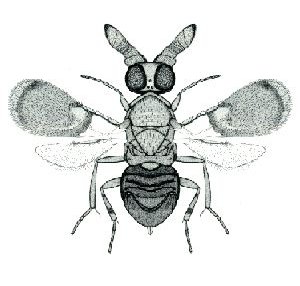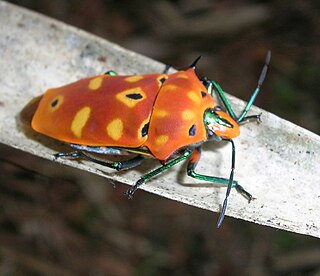
Pyrrhocoridae is a family of insects with more than 300 species world-wide. Many are red coloured and are known as red bugs and some species are called cotton stainers because their feeding activities leave an indelible yellow-brownish stain on cotton crops. A common species in parts of Europe is the firebug, and its genus name Pyrrhocoris and the family name are derived from the Greek roots for fire "pyrrho-" and bug "coris". Members of this family are often confused with, but can be quickly separated from, Lygaeidae by the lack of ocelli on the top of the head.

Encyrtidae is a large family of parasitic wasps, with some 3710 described species in about 455 genera. The larvae of the majority are primary parasitoids on Hemiptera, though other hosts are attacked, and details of the life history can be variable. They are found throughout the world in virtually all habitats, and are extremely important as biological control agents. They may also present as an ecological threat to the population of some species. For example, the endangered Papilio homerus butterfly is parasitized at a rate of 77%, making them the main contributor to egg mortality in this butterfly species.

The Leucospidae are a specialized group of wasps within the superfamily Chalcidoidea, that are ectoparasitoids of aculeate wasps or bees. They are typically mimics of bees or stinging wasps, often black with yellow, red, or white markings, sometimes metallic, with a robust mesosoma and very strong sculpturing. The hind femora are often greatly enlarged, with a row of teeth or serrations along the lower margin as in Chalcididae. The wing has a longitudinal fold. The female ovipositor is sometimes short, but if not, it is recurved and lies along the dorsal side of the metasoma, a unique feature. The males are also unusual, in the fusion of many of the metasomal segments to form a capsule-like "carapace".

Cantao is a genus of true bugs in family Scutelleridae and tribe Scutellerini.

Cantao ocellatus is a species of shield bug in the family Scutelleridae found across Asia. Reddish or ochre in overall colour it has dark legs and bluish black antennae. A dark bluish black stripe is present along the central line of the head. The pronotum sometimes has two black spots on the front margin and sometimes has eight spots. The scutellum has eight or six black spots of variable size but with yellowish borders. The lateral angle of the pronotum is elongated into a curved spine but this can be much reduced. A distinctive symbiotic bacterial genus Sodalis from phylum Gammaproteobacteria is found in its midgut. Maternal care of eggs and nymphs has been noted in this species. The female stands over and covers the eggs after they are laid but eggs on the edge that she cannot cover are often parasitized by wasps.

Eucallipterus tiliae, also known as the linden aphid or lime-tree aphid, is a member of the family Aphididae. Native to Eurasia in recent times, it is now found worldwide wherever species of Tilia occur.

Zigrasimecia is an extinct genus of ants which existed in the Cretaceous period approximately 98 million years ago. The first specimens were collected from Burmese amber in Kachin State, 100 kilometres (62 mi) west of Myitkyina town in Myanmar. In 2013, palaeoentomologists Phillip Barden and David Grimaldi published a paper describing and naming Zigrasimecia tonsora. They described a dealate female with unusual features, notably the highly specialized mandibles. Other features include large ocelli, short scapes, 12 antennomeres, small eyes, and a clypeal margin that has a row of peg-like denticles. The genus Zigrasimecia was originally incertae sedis within Formicidae until a second species, Zigrasimecia ferox, was described in 2014, leading to its placement in the subfamily Sphecomyrminae. Later, it was considered to belong to the distinct subfamily Zigrasimeciinae.

Helophilus fasciatus, the narrow-headed marsh fly, is an abundant species of syrphid fly observed throughout the United States and Canada. Hoverflies can remain nearly motionless in flight. The adults are also known as flower flies for they are commonly found on flowers, from which they get both energy-giving nectar and protein-rich pollen. The larvae of this genus are associated with wet decaying organic material, particularly accumulations of decaying vegetation in ponds and mud and farmyard manure or silage. The adults of this species lays eggs on vegetation overhanging the water. The larvae hatch and drop into the water.

Helophilus lapponicus, the Yellow-margined Marsh Fly, is a common species of syrphid fly observed across northern North America, northern Europe, Greenland and Siberia. Hoverflies can remain nearly motionless in flight. The adults are also known as flower flies for they are commonly found on flowers, from which they get both energy-giving nectar and protein-rich pollen. Though common the larvae of this species are not known but the larvae of other species in this genus are associated with wet decaying organic material, particularly accumulations of decaying vegetation in ponds and mud and are a so called rat-tailed type.

Helophilus obscurus , the Obscure Marsh Fly, is a common species of syrphid fly observed throughout Canada and the northern United States and Rocky Mountains. Hoverflies can remain nearly motionless in flight. The adults are also known as flower flies for they are commonly found on flowers, from which they get both energy-giving nectar and protein-rich pollen. The larvae of this genus are associated with wet decaying organic material, particularly accumulations of decaying vegetation in ponds and mud and farmyard manure or silage the larvae of this species are not known.
Trypeticus (Trypeticus) bombacis, is a species of clown beetle found in many Oriental countries including India.
Astycus apicatus, is a species of weevil found in Sri Lanka.
Astycus immunis, is a species of weevil found in Sri Lanka.
Episomus figuratus is a species of weevil found in Sri Lanka.
Megalocaria dilatata, is a species of lady beetle native to India, Sri Lanka and Bhutan.
Sphegina (Asiosphegina) amamiensis is a species of hoverfly in the family Syrphidae found in Japan. It is easily identified by the wide bifid lobe on the male sternum IV which is located on the right side; in most other species it is located on the left.
Sphegina quadrisetae is a species of hoverfly in the family Syrphidae found in China. It's characterized by the long black pile posterior of the posteromedial corner of the eye, the scutellum with four long black setae at posterior margin, and the black and extremely strongly antero-ventrally projected face.

Meromacrus gloriosus, the Glorious Elegant, is a species of syrphid fly in the family Syrphidae. Originally described from Mexico by Frank Hull in 1941 this black and yellow wasp mimic has since been observed in many locations in Texas and New Mexico.

Scutellista is a genus of chalcid wasps. They are parasitoids of scale insects.

Eunotus is a genus of chalcid wasps. Most species are parasitoids of scale insects.












